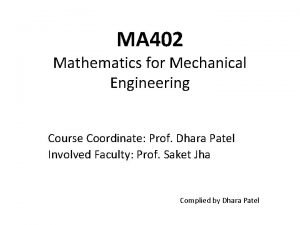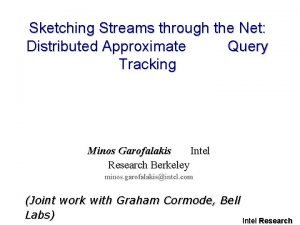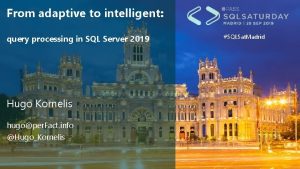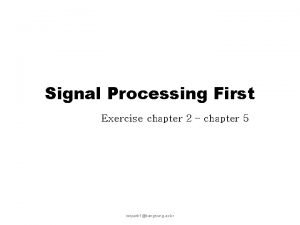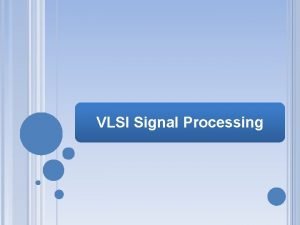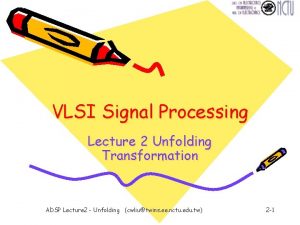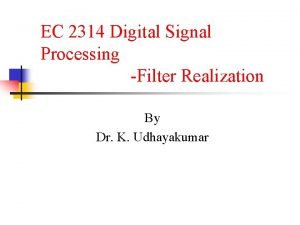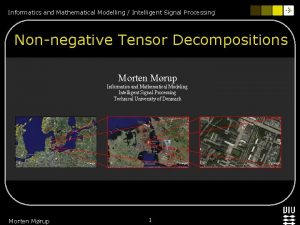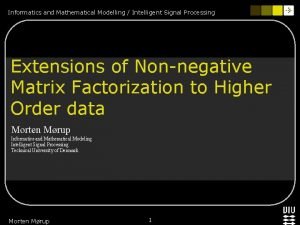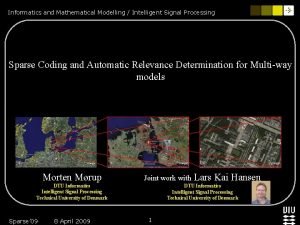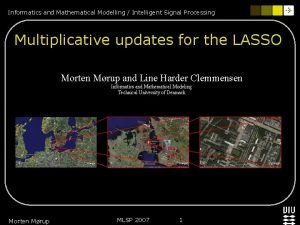Informatics and Mathematical Modelling Intelligent Signal Processing Approximate












- Slides: 12

Informatics and Mathematical Modelling / Intelligent Signal Processing Approximate L 0 constrained NMF/NTF Morten Mørup Informatics and Mathematical Modeling Technical University of Denmark Work done in collaboration with Ph. D Kristoffer Hougaard Madsen Informatics and Mathematical Modeling Technical University of Denmark Professor Lars Kai Hansen Informatics and Mathematical Modeling Technical University of Denmark Morten Mørup ISCAS 2008 1

Informatics and Mathematical Modelling / Intelligent Signal Processing Non-negative Matrix Factorization (NMF) V WH, V≥ 0, W≥ 0, H≥ 0 (Lee & Seung – Nature 1999) NMF gives Part based representation! Morten Mørup 2

Informatics and Mathematical Modelling / Intelligent Signal Processing NMF based on Multiplicative updates Step size parameter Morten Mørup 3

Informatics and Mathematical Modelling / Intelligent Signal Processing fast Non-Negative Least Squares, f. NNLS Active Set procedure (Lawson and Hanson, 1974) Morten Mørup 4

Informatics and Mathematical Modelling / Intelligent Signal Processing NMF not in general unique!! V=WH=(WP)(P-1 H)=W’H’ (Donoho & Stodden, 2003) Morten Mørup 5

Informatics and Mathematical Modelling / Intelligent Signal Processing FIX: Impose sparseness (Hoyer, 2001, 2004 Eggert et al. 2004) n Ensures uniqueness n Eases interpretability (sparse representation factor effects pertain to fewer dimensions) n Can work as model selection (Sparseness can turn off excess factors by letting them become zero) n Resolves over complete representations (when model has many more free variables than data points) L 1 used as convex proxy for the L 0 norm, i. e. card(H) Morten Mørup 6

Informatics and Mathematical Modelling / Intelligent Signal Processing Least Angle Regression and Selection(LARS)/Homotopy Method Morten Mørup 7

Informatics and Mathematical Modelling / Intelligent Signal Processing Controlling sparsity degree (Patric Hoyer 2004) Controlling sparsity degree (Mørup et al. , 2008) Sparsity can now be controlled by evaulating the full regularization path of the NLARS Morten Mørup 8

Informatics and Mathematical Modelling / Intelligent Signal Processing New Algorithm for sparse NMF: 1: Solve for each column of H using NLARS and obtain solutions for all values of (i. e. the entire regularization path) 2: Select -solution giving the desired degree of sparsity 3: Update W such that ||Wd||F=1, according to Repeat from step 1 until convergence Morten Mørup 9 (Eggert et al. 2004)

Informatics and Mathematical Modelling / Intelligent Signal Processing CBCL face database Morten Mørup USPS handwritten digits 10

Informatics and Mathematical Modelling / Intelligent Signal Processing Morten Mørup 11

Informatics and Mathematical Modelling / Intelligent Signal Processing Conclusion n New efficient algorithm for sparse NMF based on the proposed non-negative version of the LARS algorithm n The obtained full regularization path admit to use L 1 as a convex proxy for the L 0 norm to control the degree of sparsity given by n The proposed method is more efficient than previous methods to control degree of sparsity. Furhtermore, NLARS is even comparable in speed to the classic efficient f. NNLS method. n Proposed method directly generalizes to tensor decompositions through models such as Tucker and PARAFAC when using an alternating least squares approach. Morten Mørup 12
 Mathematical modelling of mechanical systems
Mathematical modelling of mechanical systems Mathematical modelling of mechanical systems examples
Mathematical modelling of mechanical systems examples Sketch techniques for approximate query processing
Sketch techniques for approximate query processing What is mathematical economics
What is mathematical economics Sql server intelligent query processing
Sql server intelligent query processing Baseband signal and bandpass signal
Baseband signal and bandpass signal Baseband signal and bandpass signal
Baseband signal and bandpass signal Classification of signals
Classification of signals Digital signal as a composite analog signal
Digital signal as a composite analog signal 인과성
인과성 Parallel system tsample ---- tclock
Parallel system tsample ---- tclock Unfolding in vlsi signal processing
Unfolding in vlsi signal processing Ec2314 digital signal processing
Ec2314 digital signal processing

